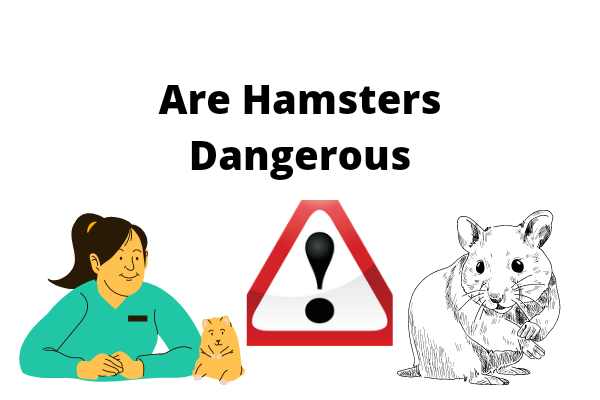9 Common Hamster Sickness Symptoms

Hamster sickness symptoms are an important part of keeping a hamster, this is to avoid sudden death.
If you pay attention to your hamster’s behavior and feeding, you will definitely observe when they are sick.
I will be discussing all the most common hamster sickness symptoms you should know and keep a tab on.
Hamster sickness symptoms
Here are some of the most common hamster sickness symptoms you should know:
1. Loss of appetite
One of the most typical indicators of illness in hamsters is a lack of appetite, which might explain why they aren’t eating or drinking.
When a hamster is on the verge of any type of illness, he or she refuses to eat or drink, owners will observe this behavior.
There may be signs of dehydration as well as rapid or severe weight loss, all of these signs can be facilitated by a lack of appetite.
Despite the fact that hamsters sleep during the day, they require frequent feeding, keep track of whether or not your hamster is eating and how much he’s eating.
If your hamster is eating less but still eating, keep a close check on him during the following day or two.
You should take your hamster to the veterinarian as soon as possible if he stops eating.
2. Diarrhea
Ascertain that your hamster does not suffer from diarrhea as a result of consuming tainted food.
The hamster ailment wet tail is very common, and it is followed by diarrhea.
It might indicate a serious infection or the death of your hamster. In the base of your hamster’s tail, look for a wet, mucus-like substance.
If your hamster has diarrhea and changes in food or activity levels, it’s probable that he or she has a wet tail, or it is one of the hamster sickness symptoms.
A wet tail might be lethal within 48 hours. As a result, you must take immediate action and seek advice from a veterinarian.
If a wet tail is observed, antibiotics, anti-diarrhea medicine, or fluids may be prescribed by the veterinarian.
3. Hair loss or unkempt coat
Take a look at the coat of the hamster. In most situations, a hamster’s fur should be full and shiny.
If your hamster’s fur begins to fall out in clumps, he may be sick or dying.
Look for redness, swelling, and abscesses, all of which are signs of infection in hamsters as they become sick.
If your hamster is ill, hair loss is one of the most common signs to look out for.
4. Sticky or dull eyes
As your hamster gets sick, his or her eyes will begin to change and it will be very noticeable to the owner, their eyes may get more matte and sticky.
When a piece of dust or bedding becomes trapped in an aged hamster’s eye while they are resting, the condition is known as a sticky eye.
As a result, their eyeballs get stuck together when they wake up, this can also be caused by other illnesses.
You may help them get out by gently cleaning their eyes with a dampened handkerchief if it is the case of stuff falling into their eyes.
If something did fall into their eyes then you should know is a warning sign of illness.
5. Hamster increased inactivity
If your hamster sleeps most of the day, don’t be alarmed if he or she rests frequently when the sun is shining.
A hamster that is not moving and appears apathetic or sluggish might be a symptom of disease, stress, or death.
Unlike a stressed rodent, a sick hamster is usually unable to move or respond to stimuli from its environment.
If your hamster looks to be less energetic and vibrant than normal during the next several days, pay close attention.
If your hamster’s activity levels do not return to normal, take him to the vet.
Hamsters will hibernate if the temperature remains cold for a lengthy amount of time.
If you believe your hamster is hibernating, warm up the area and make sure there is food and water accessible when it wakes up.
As evidenced by what seems to be a very deep slumber and very shallow breathing.
6. Discharge from the eyes, ears, or nose
In particular, look for a runny nose, red or irritated eyes, and swollen cheeks.
Hamsters have a runny nose when they’re sick, and they’re especially sensitive to colds.
These infections are normally not life-threatening, but if they persist, see a veterinarian.
Food is transported by your hamster through pouches on his cheeks.
These pouches may be unhealthy if they appear to be full for an extended length of time.
Any hamster discharge that is bloody should be recorded.
If you see blood coming out of the hamster’s eyes, nose, ears, mouth, or anus, it means it’s sick and about to die.
7. Noisy and heavy breathing
Look for signs that you’re having trouble breathing. It’s possible that your hamster is sick if he or she is gasping or puffing.
Noisy and heavy breathing are also signs of respiratory distress, which can be life-threatening.
A hamster’s vital signs will change as it approaches death. Its breathing may become labored, its heart rate may decrease, and its body temperature may fall.
The time it takes for a hamster’s capillaries to refill will also increase, and its mucous membranes will take longer than 2 seconds to recover to their normal color.
In cases of poisoning or severe oxygenation problems, the mucous membranes may seem strangely colored, white, or blue.
8. Continuous weight loss
This is usually the first hamster sickness symptoms you should look out for.
You will notice this is you often play with your hamster.
Because ill hamsters lose their appetite, they are more likely to lose a significant amount of weight.
You should take your hamster to the vet if he or she begins to lose weight unnecessarily.
9. Alterations in behavior
Keep an eye on your hamster’s behavior and appearance for any changes.
In individuals who are badly affected, a damp tail might produce sleepiness and a ruffled coat.
Furthermore, a hamster with a serious, life-threatening disease may become immobile and refuse to eat.
Pain and vulnerability in hamsters can cause them to modify their behavior, making them more fearful, aggressive, and agitated than usual.
Hamster illnesses
Here are the most common hamster illnesses you should know:
1. Wet Tail
One of the most frequent hamster ailments is a wet tail, which can be caused by stress, crowding, or dietary changes.
Wet tail is a bacterial illness that causes watery diarrhea and dehydration in longhaired and teddy bear hamsters.
It is treatable, yet it can be deadly if not caught early enough.
Diarrhea, producing dampness around the tail, tiredness, loss of appetite, a humped back, and a ruffled coat are all indications to look for.
2. Diarrhea
Overfeeding of fresh vegetables is the most prevalent cause of diarrhea in hamsters.
There is no lack of appetite or decreased activity, unlike wet tail. The hamster will seem normal for the most part.
Allowing diarrhea to persist for an extended amount of time might lead to dehydration.
If diarrhea persists for more than a day, consult your veterinarian, whether it is due to a change in food or something else.
3. Skin diseases
Hamsters can be infected with a variety of skin and hair mites, which can be identified by a skin scraping performed by your veterinarian.
Ringworm, a fungal infection, allergic dermatitis, and skin diseases can all affect the skin and need veterinary care.
Hair loss in hamsters is relatively uncommon, and it can be seasonal or occur in elderly hamsters.
However, if the hamster’s skin is flaky, red, or has sores, or if the hamster is scratching more than normal, a veterinarian should be consulted.
Scent glands on the flanks of hamsters can be black and cause worry in their owners.
In these circumstances, you should consult a veterinarian to discover the specific source of your skin problem.
4. Respiratory Infection
Respiratory infections in hamsters can lead to pneumonia. Sneezing, drainage from the eyes or nose, wheezing, and hard breathing are all symptoms of a respiratory infection.
Sneezing sometimes isn’t a big deal, but if there’s a loss of appetite, decreased activity, wheezing, or breathing problems, you should seek veterinarian help right once.
5. Tumors
The packed cheek pouches of your hamster may appear strange to the untrained eye, yet this is normal behavior for these scavengers.
However, if you see lumps and bumps in other parts of your hamster’s body, these swellings might indicate abscesses or tumors.
How to care for sick hamsters
The most frequent approaches to care for and comfort a sick hamster are as follows:
- Providing Your Hamster with a safe and comfortable Environment
- Clean up the old surroundings before moving your hamster to a new home.
- Avoid dehydration as soon as feasible.
- Holding your hamster may bring warmth and comfort.
- Your hamster’s food and water should be changed.
- Place the food and water dishes of your hamster close together.
- The amount of protein in your hamster’s feed should be increased.
- Feed your hamster by hand or using a syringe if he can’t eat on his own.
- It’s not a good idea to let your hamster eat too much at once.
- Medication for pain relief should be available.
- Keep an eye out for both severe and small signs of illness.
Here are some common ways to comfort a dying hamster.






